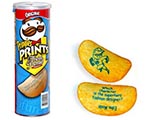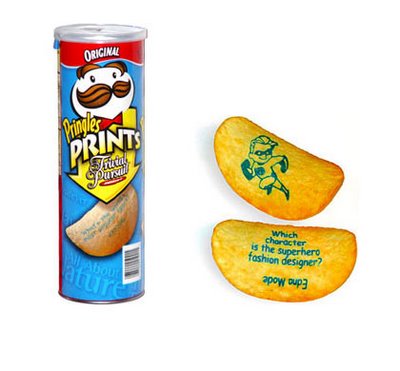Open Innovation: Pringles Print
Published Oct-30-09Breakthrough:
A ground-breaking process to print edible dye images on potato crisps. It drastically cut the cost of development, and dramatically reduced the concept to market time.
Company:
Bakery in Bologna, Italy
The Story:
 Procter and Gamble are open innovation giants, with more than 35% of their new ideas coming from outside sources. However, it hasn’t always been this way.
Procter and Gamble are open innovation giants, with more than 35% of their new ideas coming from outside sources. However, it hasn’t always been this way. Historically P&G relied on internal resources and a network of trusted contacts to design, develop and supply new products and services. This would usually sustain their annual growth goal of 4-6%. But as the new century dawned analysis revealed that the multinational company would not reach their targets if it relied solely on internal innovation. It was crunch time. So former CEO A.G. Lafley decided that up to 50% of innovation must come in from the outside. The ideas landscape was changing and democratizing innovation was now being viewed as a viable means to develop new billion dollar businesses.
Crisp Innovation
A perfect illustration of harnessing external ideas and putting them into practice is a line of Pringles potato crisps that Procter & Gamble launched in 2004. Each crisp had pictures, trivia questions, facts, and jokes printed on them. The product was called Pringles Print and was an immediate hit.
The idea first came to the surface in 2002 during a brainstorming session when P&G were thinking about ways of making snacks more fun. Someone suggested printing pop culture images on the crisps, and although considered a fantastic idea, heads were being scratched to try and come up with a way of doing it. One employee suggested ink-jetting pictures onto the potato dough and a test-run was organized using an office printer.
Novel Snack Novel Approach
It soon became clear to all concerned that the novel snack needed a novel approach as it presented a more complex challenge than previously imagined. Company scientists realized that every crisp would have to be printed as it came out frying, when humidity and temperatures were still high. Moreover, multiple colors would be required, and the image resolution had to remain sharp on the thousands of crisps that would be printed each minute. Plus, the edible dyes had to meet food safety requirements.
To come up with the answers P&G decided to abandon their traditional way of going about business, which in this case, would have involved finding an ink-jet company to devise the process and then negotiating the rights to use it, which would’ve required considerable financial investment.
Instead, a brief was created which defined the challenge and the problems that needed to be solved, and it was circulated to a vast network of institutional and private contacts to see if anyone had a ready-made solution to hand.
Searching for a Solution
It was through this network that they discovered a bakery in Bologna, Italy which was being run by a university professor who also happened to manufacture baking equipment. He had already come up with a way of printing edible images on cakes and cookies and it only needed a few tweaks to be adapted to solve P&G’s problems.
In the old days, prior to open innovation it could have taken two years to bring Pringles Print to market, with Procter and Gamble stumping up the funds. But the crisp innovation hit grocery store shelves in less than a year, at a fraction of what it would otherwise have cost.
Next Story »

